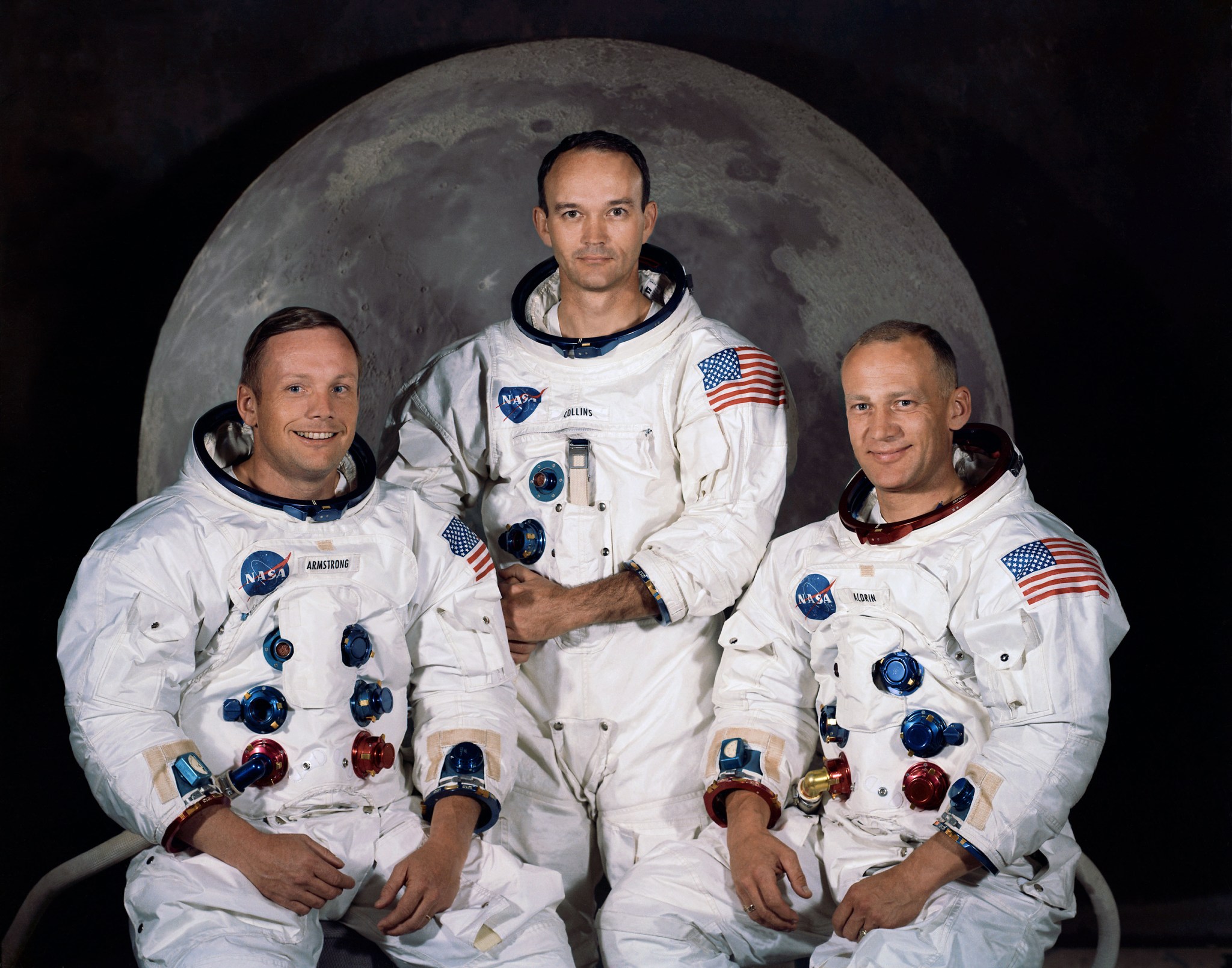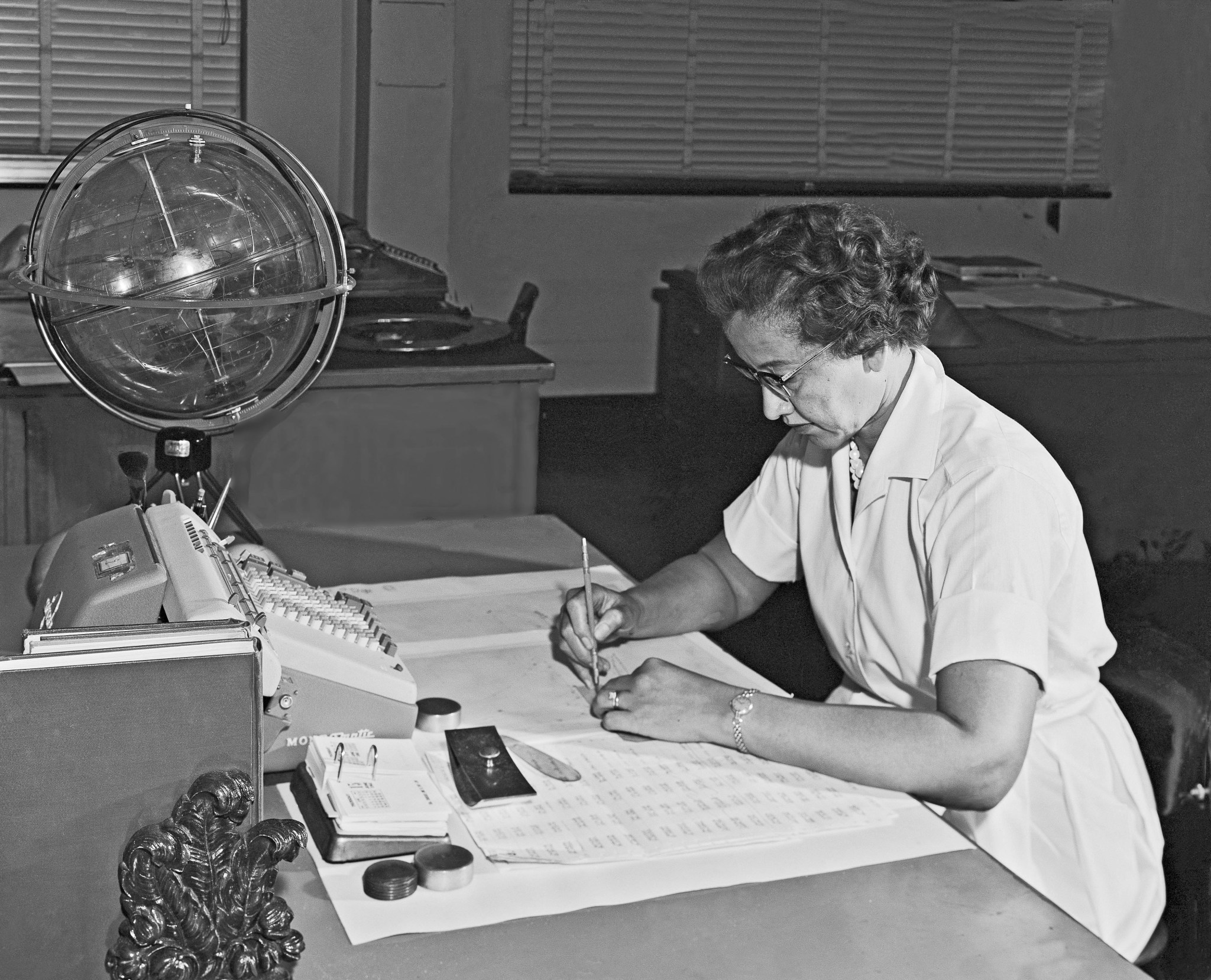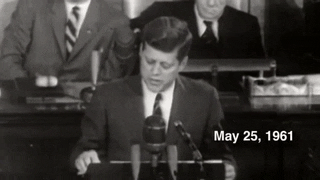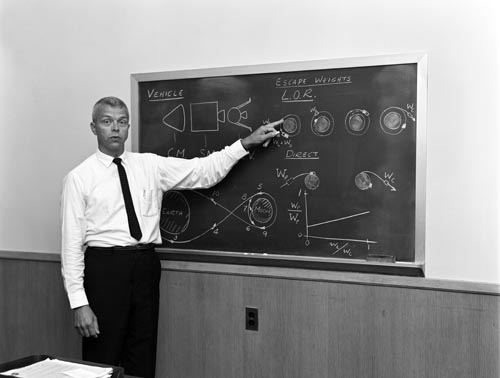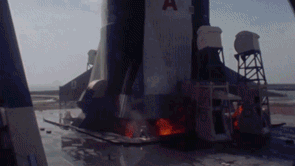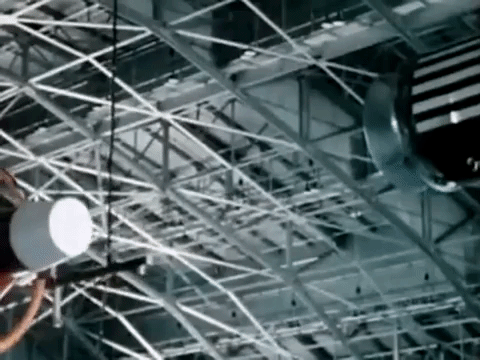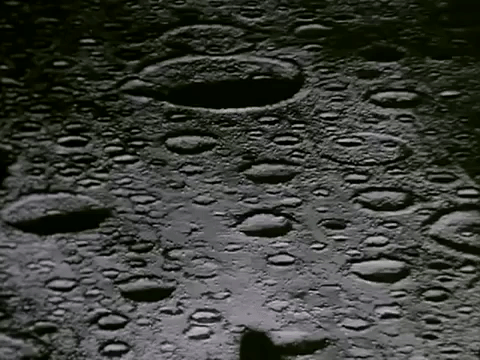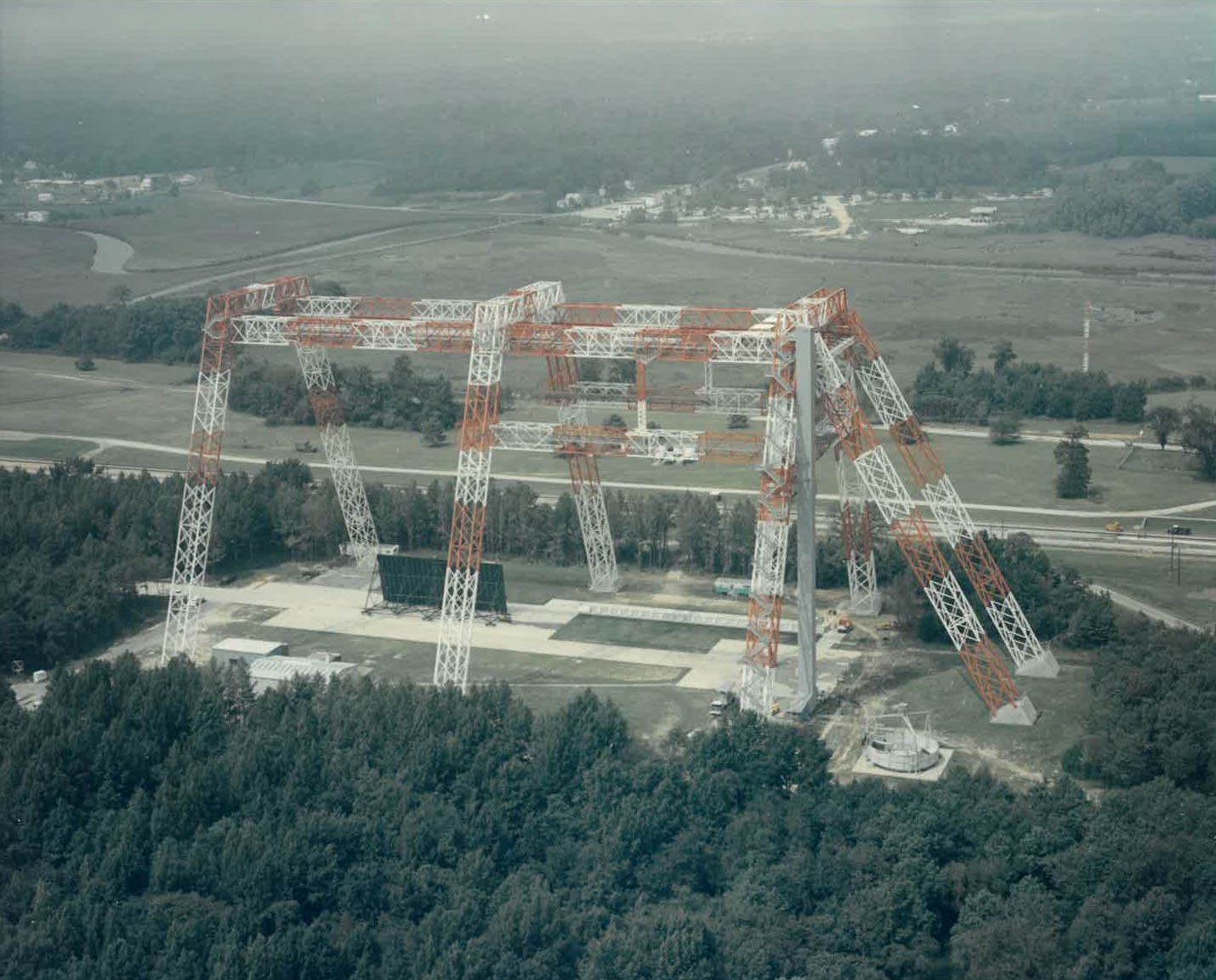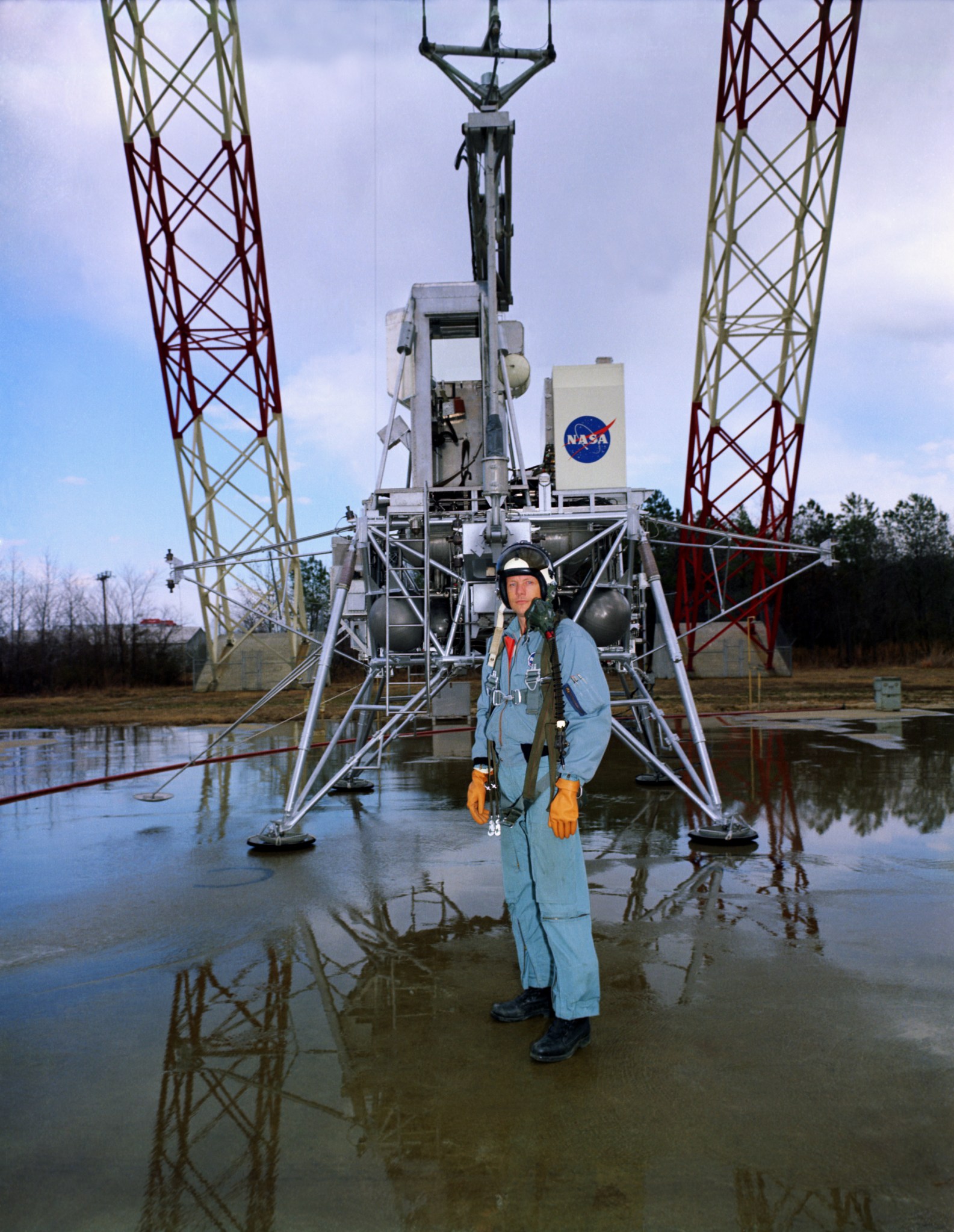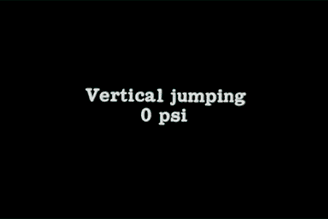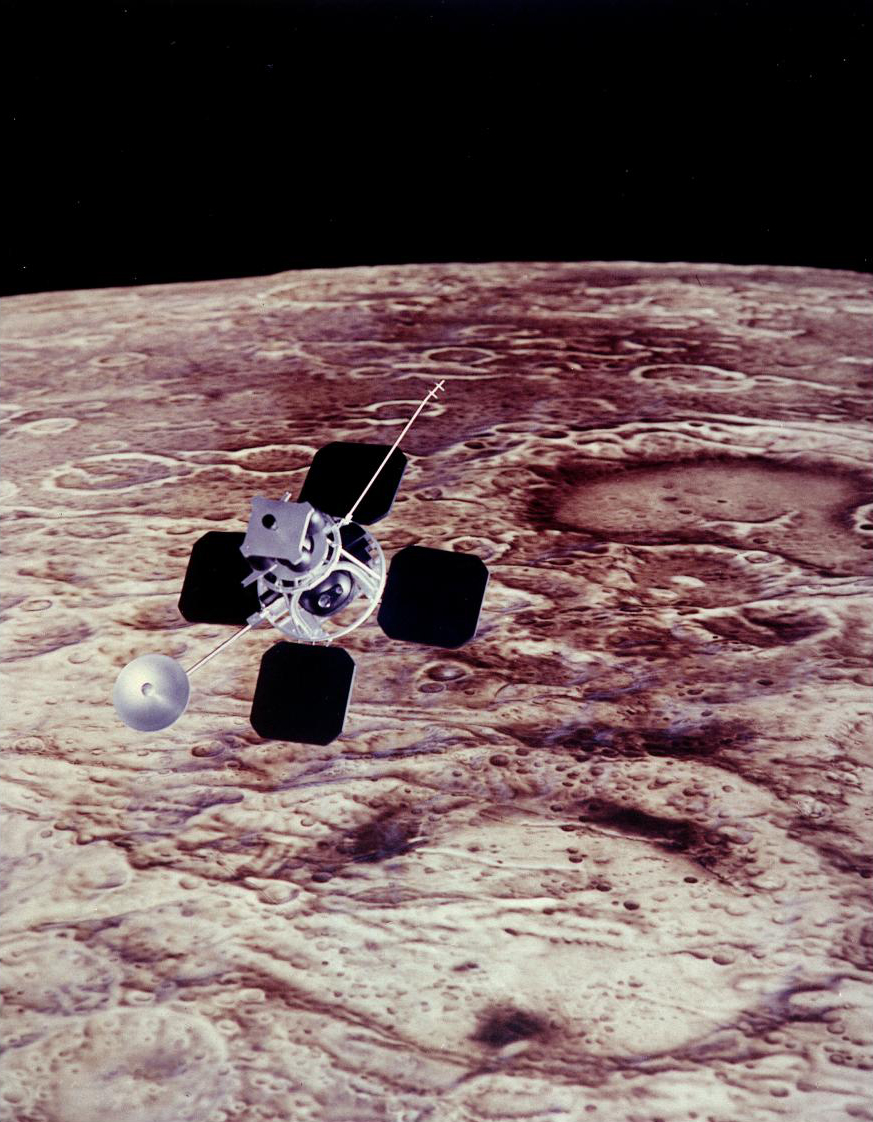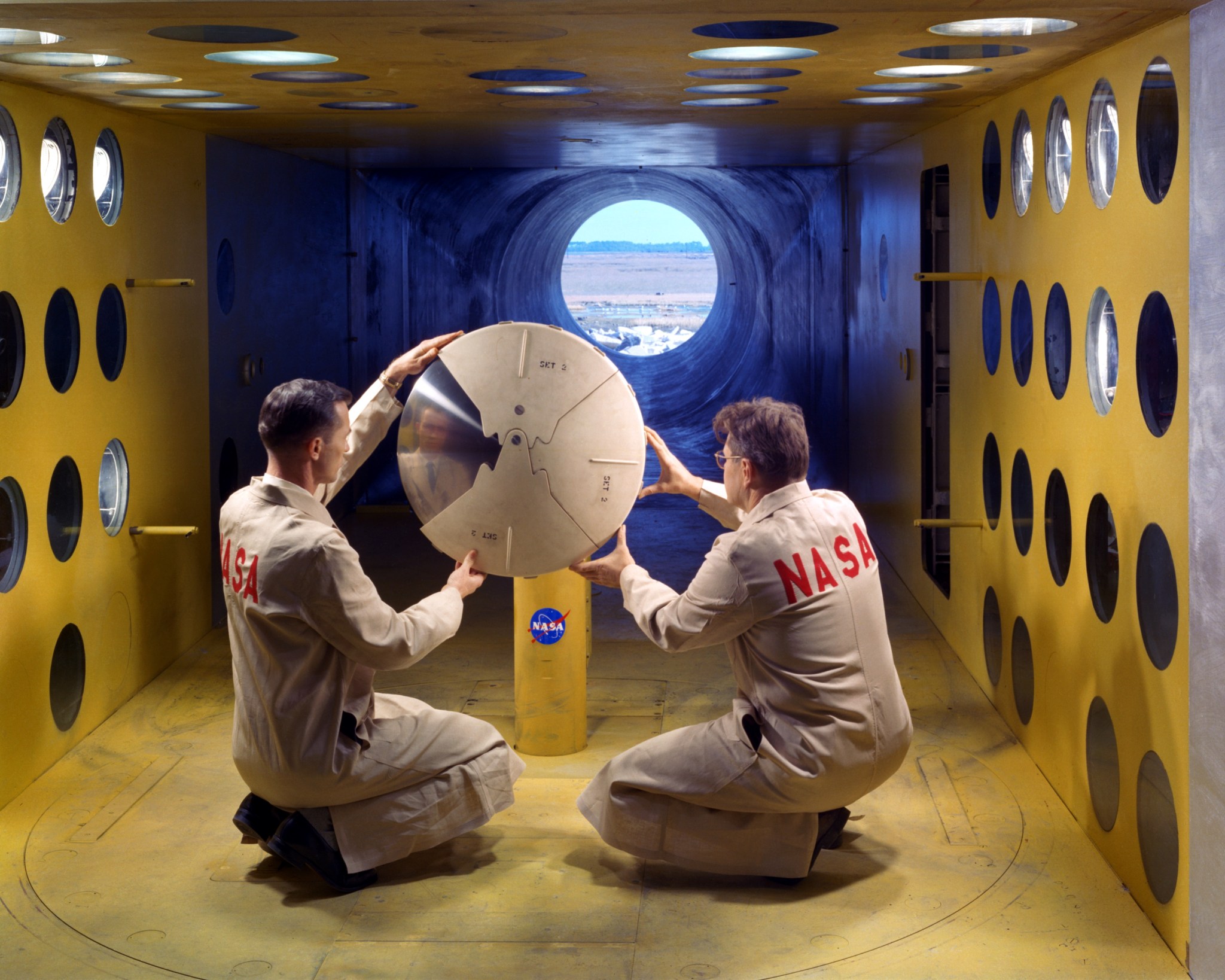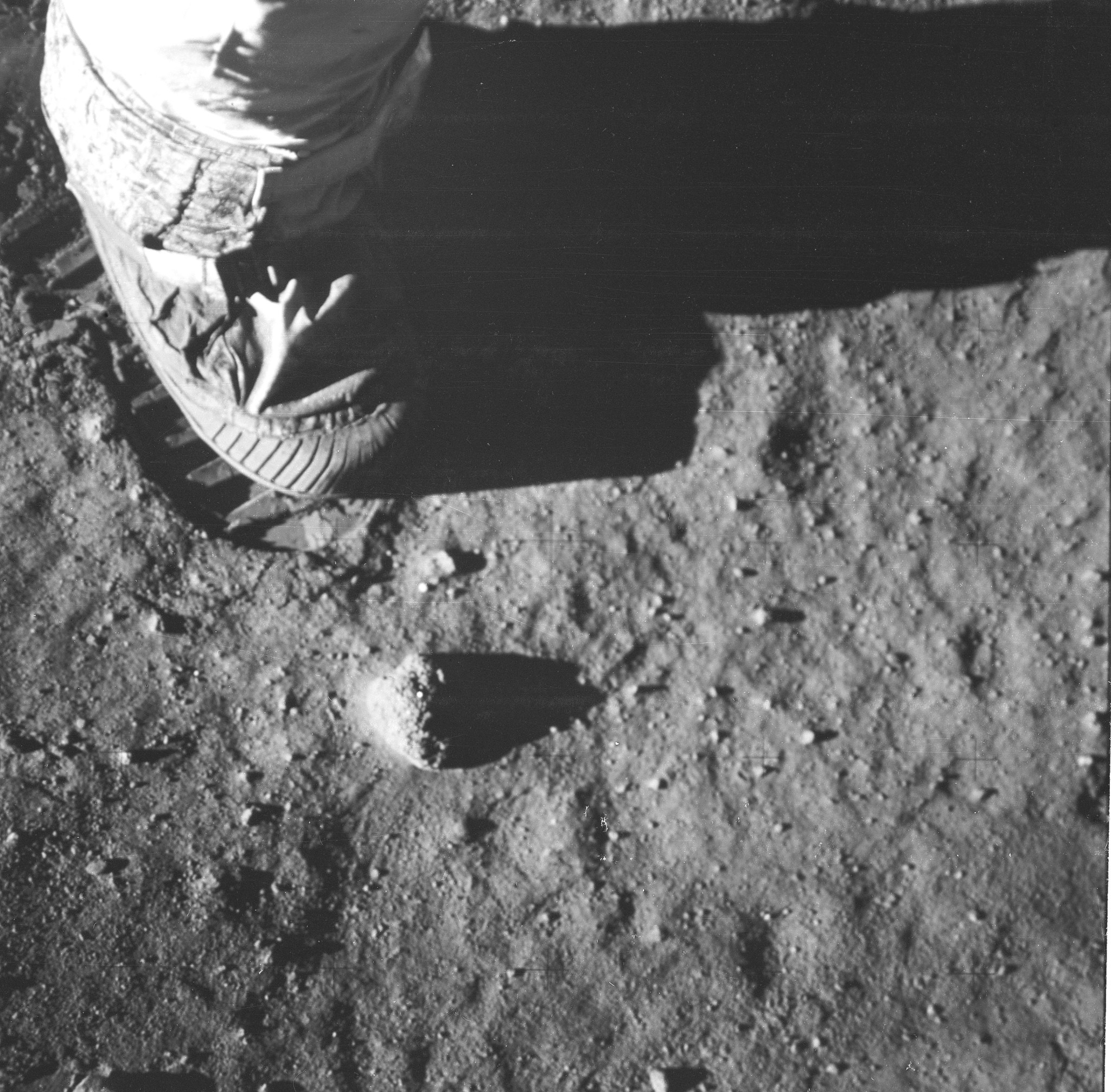Fifty years after the first manned landing on the Moon, President Kennedy’s commitment to the lunar mission sounds as bold as it ever did: American astronauts journey a quarter of a million miles to make a pinpoint landing on a faraway celestial body and return home safely after an eight-day voyage through space. When Kennedy challenged the nation to meet this incredible goal, the only United States manned spaceflight up to that time had been
Alan B. Shepard’s 15-minute suborbital excursion in Mercury capsule, Freedom 7. NASA was not exactly sure how the lunar mission should be made at all, let alone achieved in less than ten years’ time.
Answering President Kennedy’s challenge and landing men on the Moon by 1969 required an innovative burst of technological creativity, and the largest commitment of resources ($24 billion), ever made by any nation in peacetime. At its peak, the Apollo program employed 400,000 Americans and required the support of over 20,000 industrial firms and universities.
NASA’s Langley Research Center made foundational contributions, leading to the first manned lunar landing, which occurred July 20, 1969, by Apollo 11 astronauts Neil A. Armstrong, commander; Michael Collins, Command Module pilot; and Edwin E. “Buzz” Aldrin, Lunar Module pilot.
Background
Langley, established in 1917, was the first U.S. national laboratory devoted to the advancement of the science of flight. Long before the space program, scientists and engineers at Langley incubated the ideas and hatched the technology that made American aviation take off and fly. For more than 100 years now, information from the laboratory’s wind tunnels, pressure tunnels, gas dynamic labs and other unique research facilities has played a vital role in advancing American performance in the air.
Langley gave birth to key components of the U.S. space program. As early as 1952, Langley researchers explored seriously the possibilities of manned flight into space, six years before the creation of NASA. Out of these pioneering studies grew the NASA Space Task Group that conceived and directed Project Mercury, America’s original man-in-space program. Langley provided much of the knowledge and know-how basic to the development of the Mercury spacecraft and its related systems, as well as to the creation of the worldwide tracking network that monitored the first space shots. Among the many who worked on Project Mercury and other related projects were Katherine Johnson, Mary Jackson, Dorothy Vaughan, and the West Computers. Furthermore, it was at Langley where the original team of NASA astronauts (Alan Shepard, Virgil “Gus” Grissom, John Glenn, Scott Carpenter, Donald “Deke” Slayton, Walter Schirra and Gordon Cooper) received their basic training. Without the Langley Research Center and their dedicated scientists, engineers and researchers, the space program as we see it today would not be possible.
How to get to the Moon?
When President Kennedy made his historic decision in May 1961, NASA had already studied various ways by which to land men on the Moon but the agency was still uncertain which one was best. Mission planners quickly narrowed the options down to three: direct ascent, Earth-orbit rendezvous (EOR) and lunar-orbit rendezvous (LOR).
Of the three, LOR was initially the least popular inside of NASA due to what was then considered its greater complexity and risk.
In July 1962, however, after months of evaluation and intense debate, NASA selected LOR as the primary mission mode by which to land Americans on the Moon “before the decade is out.”
Direct ascent, the first choice of many NASA officials, was ruled out because the huge new launch vehicle required to accomplish the mission –the proposed Nova rocket — would take too much time to develop. The EOR concept was ruled out because it required two separate launch vehicles.
NASA selected LOR only after Langley researchers proved the feasibility of rendezvous in space and revealed the important engineering and economic advantages of a manned Moon landing through lunar-orbit rendezvous. Advocates of LOR at Langley played vital roles in convincing NASA leadership that LOR was not only as safe as either direct ascent and Earth-orbit rendezvous but also it promised mission success some months earlier.
Lunar-Orbit Rendezvous (LOR) Concept
John C. Houbolt was credited with leading a team that experimented with the Lunar Orbit Rendezvous (LOR) concept since 1959. The basic premise of LOR was to fire an assembly of three spacecraft into Earth orbit on top of a single powerful rocket (the Saturn V). Once endorsed by Robert Gilruth, Wernher von Braun and the original true believers at Langley Research Center, NASA chose to move forward with the LOR concept.
This assembly would include:
- a mother ship or command module (CM);
- a service module (SM) containing the fuel cells, attitude control system and main engine;
- and a small lunar lander or excursion module (LEM).
Once in Earth orbit, the last stage of the rocket would fire, boosting the combined Apollo spacecraft into its flight trajectory to the Moon. In lunar orbit, two crew members would don space suits and climb into the Lunar Excursion Module (LEM) and take it down to the surface. The third crew member would maintain a lonely vigil in lunar orbit inside the mother ship. After exploring, the LEM would rocket back up and re-dock with the CM. The lander would then be discarded to the vastness of space or crashed into the Moon, and the three astronauts in their command ship would head for home.
Langley’s bold plan for rendezvous in lunar orbit held out the promise of achieving a manned landing on the Moon by 1969, but it presented many technical difficulties. Success depended on NASA’s ability to train astronauts to master the techniques of landing the LEM on the lunar surface and returning it to orbit and docking with the mother ship.
Several of the most significant facilities used to develop techniques for LOR and prepare the astronauts for Apollo missions were designed, built and operated by the Langley Research Center. These included the rendezvous simulator, the lunar landing simulator, the lunar orbiter project, extravehicular activity and aerodynamics and structures research.
Rendezvous Docking Simulator
One of the trickiest yet most essential maneuvers that had to be perfected on the ground before it could be tried in space was the linking of the Lunar Excursion Module and the Command Module. The ability to rendezvous and dock the two vehicles in space was critical to the success of LOR, because if there were a failure the two astronauts in the LEM would have no means to return to Earth — and NASA would have no means to rescue them. The first men on the Moon, international heroes, would die inside the LEM, and the commander of the CM would be forced to leave his buddies in their orbiting coffin and head for home alone. Nothing was secretly more terrifying to the CM commander than this possibility.
NASA had to do everything it could to make sure that this tragedy did not happen.
In the early 1960s, Langley researchers built various simulators to study the feasibility of space rendezvous and orbital docking. The most advanced of these, the Rendezvous Docking Simulator, significantly improved the chances of mission success through LOR by giving the astronauts a routine opportunity to pilot dynamically-controlled scale-model vehicles in a safe and controlled three-dimensional environment closely approximating that of space.
Rendezvous in space could turn sour with paralyzing swiftness. An onboard computer might fail, a gyroscope might tilt the wrong way, or some other glitch might occur to complicate the performance of a necessary maneuver. Pilots of both the LEM and the CM had to be ready to make crucial decisions instantaneously. Without Langley’s Rendezvous Docking Simulator, the astronauts would not have been nearly as well prepared for handling the pressures of LOR. With the help of this ingenious device, they were able to master all of the necessary rendezvous and docking skills before liftoff.
Lunar Landing Research Facility
Before confronting the serious challenges of rendezvous and docking, the goal of the Apollo astronauts was first to achieve a successful lunar landing. To help solve this part of the overall problem of a LOR mission, Langley engineers constructed the Lunar Landing Research Facility.
NASA needed such a facility in order to explore and develop techniques for landing the rocket-powered LEM on the Moon’s surface, where the gravity is only one-sixth as strong as on Earth, as well as to determine the limits of human piloting capabilities in the unknown flight medium.
Although NASA did use helicopters in the early 1960s to ascertain some of the problems of vertical descent to a lunar landing, there were no direct parallels between flying an aircraft in the Earth’s atmosphere and piloting the LEM in the vacuum of space. If there had been parallels, the LEM would have looked something like a conventional aircraft — which it absolutely did not.
Langley researchers, because they were the early champions of LOR inside of NASA, played the leading role in the original conceptualization of the Lunar Excursion Module, and they knew that the pilot of this vehicle, however its final design turned out, would have to overcome some distinctly unusual problems.
In technical terms, control of the LEM required small rockets that operated in an on-off manner. The firing of these control rockets in space produced abrupt changes in torque forces that tended to produce rotation or rolling — rather than the smoothly modulated torques of a helicopter.
Furthermore, the LEM would hover in space with only one-sixth of the thrust required for a vehicle of the same weight in Earth’s gravity. This meant that the characteristics of the LEM’s control system would be significantly different from those of any flight vehicle to which the astronauts were accustomed. They could not simply extrapolate from atmospheric flight to flight in lunar conditions. In key respects, in fact, some of their basic previous experience in flying machines might even confuse them and get in their way.
Langley’s Lunar Landing Research Facility, completed in 1965, helped to prepare the Apollo astronauts for the final 150 feet of their lunar landing mission by simulating both the lunar gravity environment and full-scale LEM vehicle dynamics. The builders of this unique facility effectively canceled all but one-sixth of Earth’s gravitational force by using an overhead partial-suspension system that provided a lifting force by means of cables acting through the LEM’s center of gravity.
Twenty-four astronauts practiced lunar landings at this facility, the base of which was modeled with fill dirt to resemble the surface of the Moon. Neil Armstrong and Buzz Aldrin trained on it for many hours before liftoff of Apollo 11. As was the case with all space missions, the successful landings of the first two men on the Moon depended heavily on expert training in ground equipment like Langley’s Rendezvous Docking Simulator and Lunar Landing Research Facility.
Langley provided critical information about the lunar landing in other ways as well. A hydraulic analog simulator built at the laboratory in the early 1960s helped researchers determine the ability of a pilot to control vertical braking maneuvers for landings starting from an altitude of about 25 miles above the lunar surface. There was also a special facility using one-sixth scale models of the LEM that looked into the possibility of an impact that could damage or upset the fragile-looking vehicle upon landing. Another laboratory apparatus probed the anticipated and much-feared problem that blowing lunar dust caused by the blast of rocket engines might temporarily blind the pilot of the LEM during descent and prevent him from finding a safe spot for landing.
Extravehicular activity
Along with comprehensive studies of astronaut capabilities and mobility in space both inside a spacecraft and during “spacewalks,” researchers at Langley also contributed significantly to NASA’s understanding of what the Apollo astronauts would and would not be able to do while moving around on the lunar surface.
In the Reduced Gravity Simulator, researchers investigated an astronaut’s ability to walk, run and perform the other tasks required in lunar exploration activities. With this facility, NASA studied the effects of one-sixth gravity on self-locomotion by suspending the subject on his side so that he was free to walk on a plane inclined to about 80.5 degrees relative to the local horizons. Holding up the lunar walker so he would not fall was a network of slings and cables. This was attached to a lightweight trolley that traveled freely along an overhead track that was part of the larger Lunar Landing Research Facility.
A number of the Apollo astronauts practiced lunar walking in Langley’s Reduced Gravity Simulator.
Lunar Orbiter Project
Through its management of the Lunar Orbiter Project, which involved systematic photography of the Moon’s surface by an unmanned spacecraft in lunar orbit, Langley also played a significant role in the selection of the sites of the Apollo manned landings.
Before NASA could give the go-ahead for a landing attempt, many details had to be learned about the nature of the destination. Although humankind had moved some distance from the fantasy that it was made of green cheese, there still existed all kinds of wild theories about the Moon. One theory said that its surface was covered by a fine layer of dust perhaps 50 feet thick; any type of vehicle attempting to land on it would sink and be buried as in quicksand.
Earth-bound telescopes could not resolve lunar objects smaller than a football stadium, so Apollo mission planners could hardly rely on them for a detailed picture of the lunar surface. To get this information, and separate fact from fancy, NASA in the mid-1960s sent a series of unmanned missions to the Moon.
The first of these, Project Ranger, involved the hard landing of small probes equipped with a high-speed camera. Before crashing to their destruction into the Moon’s surface, the Ranger spacecraft showed that a lunar landing was possible — but definitely not just anywhere. The craters and big boulders had to be avoided.
The second probe, Project Surveyor, through its soft landings and photographic data, showed that the lunar surface could easily support the weight and the impact of a small lander.
The third, the Lunar Orbiter Project, made photographic maps of the Moon’s equatorial regions. These maps, compiled at Langley, provided NASA with the detailed topographical information needed to pinpoint the best landing sites — including the exact spot in the Sea of Tranquility chosen for Apollo 11.
Aerodynamics and structures research
Many other things were done at Langley to support Apollo. Through hundreds of hours of wind tunnel testing, researchers helped to determine the aerodynamic characteristics of the Apollo-Saturn launch configuration. In order to evaluate Apollo’s ablative heat-shield materials, an electric arc heater was used at Langley that could duplicate the intense heat generated by friction during reentry. In numerous facilities, including the 8-Foot High-Temperature Tunnel, Langley engineers conducted critical investigations into the structural integrity of Apollo.
One of the major research projects managed by NASA Langley in support of Apollo was FIRE (Flight Investigation Reentry Environment). Although this project mainly consisted of flight tests involving Atlas rockets with recoverable reentry packages, FIRE also involved wind-tunnel testing. The purpose of the project was to study the effects of reentry heating on spacecraft materials.
From lunar orbiter tracking data, staff members constructed representations of the Moon’s gravitational field. These mathematical models proved invaluable in the design and timing of critical operating maneuvers during the flight of Apollo 11 and the subsequent lunar landing missions.
Conclusion
This discussion only summarizes the high-points of Langley’s contributions to the Apollo lunar landing and exploration program. As President Kennedy indicated, the entire nation would have to go to work if Americans were to set foot on the Moon by the end of 1969.
No place was more fortunate to participate in the achievement of the lunar objective than was the Langley Research Center.
We were there for the first step and we’ll be there as NASA goes back to the Moon and on to Mars.

























